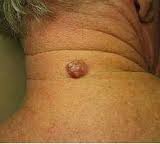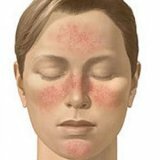Causes of Acne
 Before considering the causes of acne, you need to understand what is acne. Acne is an inflammatory disease of the skin. As a result of this disease, acne and acne are formed. Acne is a cork that clogs the way out of the sebaceous glands. Acne is the result of inflammation. From acne, in most cases, the face suffers, but they also occur on the shoulders, neck, back, chest.
Before considering the causes of acne, you need to understand what is acne. Acne is an inflammatory disease of the skin. As a result of this disease, acne and acne are formed. Acne is a cork that clogs the way out of the sebaceous glands. Acne is the result of inflammation. From acne, in most cases, the face suffers, but they also occur on the shoulders, neck, back, chest.
The reasons for the appearance of acne( or, acne) can be attributed to various factors. But, as a rule, the mechanism of their development includes the main reasons:
- hyperactivity of the sebaceous gland;
- elevated levels of male sex hormones;
- cornification of skin tissues;
- bacteria;
Let us consider each cause separately.
Hyperactivity of the sebaceous gland.
All the skin surface, except the sole and palm, cover the sebaceous glands. Under the skin, they lie at a level of 0. 5 mm. With the course of life, the depth, quantity and magnitude of them vary. At the child the sebaceous glands settle down more densely and more actively work. But over the years their activity is weakening, and part of the sebaceous glands dies away altogether. Before sexual maturation, the consistency and chemical composition of sebum changes. During puberty, sebaceous glands are acted upon by hormones( androgens), under the influence of which the secretory activity of the sebaceous glands increases. The maximum is reached by 18-25 years.
Sometimes a girl or boy, for physiological reasons, has a moment when the sebaceous glands begin to work very actively. Sebum is much more prominent, but in addition it becomes denser. Such sebum, mixing with particles of dead skin, forms a "plug" on the "outlet" from the follicle. As a result of blockage, it is first clogged, and subsequently the size of the follicle increases. If the cause is not eliminated and the surplus of fat is not taken out, then inside the follicle favorable conditions are created for the multiplication of pathogenic bacteria and microorganisms. In the sebaceous gland streptococci, staphylococcus and other pathogens are developed. As a result, numerous acne( acne) are formed.
Increased level of male sex hormones.
Violation of the hair follicle leads to the appearance of acne. Such a violation can be caused by various factors. One of the reasons is the imbalance between female and male hormones, namely estrogens and androgens. Therefore, acne can appear with any hormonal disorders. That's why acne appears in adolescence during puberty, in girls who have not had a menstrual cycle, after abortion and during pregnancy.
The level of hormones depends on physical activity, psychological state, on the intake of certain medicines, climatic conditions, etc.
As a result of the dramatic changes in the hormonal background in the hair follicle, the processes of keratinization, that is, exfoliation of old skin flakes, change. In this case, not only the production of sebum increases, but its structure also changes, the sebum becomes dense and viscous, it is more likely to block the follicle. This leads to the formation of a sebaceous-keratin plug - comedones. The bacteria multiply in the follicle, the products of vital activity of which subsequently cause inflammation.
Gynecological hormonal problems are closely related to the appearance of acne( acne).In women during the menstrual cycle, the level of steroid hormones increases, so many women associate the appearance of acne with menstruation. The appearance of acne can be associated with polycystic ovaries, postponed abortion. The reason lies in the violation of the hormonal balance. With increased production of androgens( male hormones) in women, acne is very common.
Causation of skin tissue or follicular hyperkeratosis.
Due to the fact that the dead skin scraping is done, the outer layer of the skin is constantly updated. Sometimes the horny layer grows too fast and this leads to the formation of a comedon plug. In the funnel area of the follicles, the stratum corneum becomes thicker. This process is another reason for the appearance of acne and is called "follicular hyperkeratosis" or increased keratinization of skin tissues. Heredity, deficiency of vitamins C or A are risk factors for follicular hyperkeratosis. Typical manifestations of hyperkeratosis are reddish pimples, rough, rough skin, rashes, "goosebumps" on the hips and arms.
In terms of medicine, follicular hyperkeratosis differs from acne disease. For example, on the face of rough, dry, identical in size elements of follicular hyperkeratosis. As a rule, the diagnosis is made without laboratory diagnosis, only on the basis of examination of the skin. Since it is impossible to get rid of follicular hyperkeratosis, its treatment is symptomatic. And the appearance of this disease can serve as a symptom of the pathology of internal organs. Therefore it is necessary to consult a therapist, dermatologist and endocrinologist. In case of successful treatment of the underlying disease, over time the skin condition can normalize.
The use of scrubs, peels with hyperkeratosis will only worsen the skin condition. It is necessary to use cosmetic products with emollients( fatty components) that will soften the skin, reduce irritation and improve its appearance. Bacteria and acne.
As already known, the appearance of acne begins when the follicle is clogged and the bacteria begin to accumulate and rapidly multiply. On the human skin are constantly present propionic bacteria, which are the main "culprits" for the formation of acne. In addition, dozens of other microorganisms exist on the skin, which also play a role in the formation of rosacea.
The presence of these microorganisms on the skin does not lead to acne. Another thing is when an incubator is created in the blocked follicle for these bacteria, in this case acne is formed.
Although the formation of acne is "caused" by bacteria, the disease of acne is not contagious. Since bacteria take a secondary role for the appearance of acne.
There are many other factors that can "trigger" the mechanism of acne. It can be harmful working conditions, contact with any substances, taking medications and much more. But every person who suffers from acne should make the main conclusion - if conventional means do not help, you should immediately contact a dermatologist.
To date, medicine has a sufficient number of tools and techniques for treating acne.



